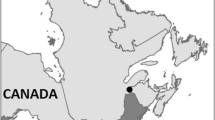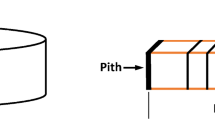Abstract
Frequently occurring red heartwood decisively restricts the volume of light-coloured beech wood, which can be processed to high-grade appearance products. Forestry and wood industry lack suitable means for maximising the yield of light timber, since the intra-tree extent of red heartwood varies considerably. The present study characterised in detail the intra-tree shape of red heartwood and its relationships to tree-external traits (dead branches, branch scars), considered as possible initiation points of red heartwood formation. An experimental method based on log scanning and image analysis was developed and applied. Using its output for three-dimensional visualisation and data analyses, external traits being linked to the local red heartwood shape were identified. Furthermore geometric relationships were established for characterising these external traits and for deriving discriminating criteria.









Similar content being viewed by others
Notes
About 25–75 cm in stem-axial direction above a wound.
Dead branches were found to be linked to the red heart as well, but their number was too small to be subjected to further analyses.
The resolutions are given in the course of the description of the different steps of the measurements.
Tacheometer: Model LEICA TCR307 reflectorless, angle measurement 5”, maximal distance measurement 80 m, accuracy 3 mm at 80 m, measurement time 3 s, magnification 30×.
The apparatus used was built in the LERFoB laboratory and is called Appareil de Mesure de l’Enveloppe des Billons (AMEB). Angular coder: HEINDENHAIN ROD 450, minimal angular step 1/100°. Laser: LIMAB LMS6035S, accuracy 0.5 mm at 600 mm. 1axis robot: CHARLY ROBOT PE225, length 2.25 m, step by step motor 140 Ncm, minimal step 12.5 μm, accuracy 0.1 mm at 2 m.
The original method was applied to sample trees B01 and B08, the modifications to C04 and C06.
Longitudinal step: 40 mm, angular step: 10° (in few cases: 15°).
Longitudinal step: 5 mm (in few cases: 10 mm), angular step: 2.5°.
Disc thickness: 5 cm.
Image size: 2048×1536 pixels.
Range = [8 mm, 24 mm] which corresponds to [38 mm, 115 mm] for 35 mm cameras; 0.56″-CCD with 3.34 million pixels.
Using the same camera and focal length, the difference between measurements on distorted and rectified images was found to be less than 1%.
In forestry practice, the term Chinese moustache is often used instead of branch scar.
Artificial pruning of green branches; tree age: about 40–50 years, branch diameter: 2.5–4.5 cm, branch inclination: 30–60°.
Artificial pruning of green branches; tree age 50–55 years, maximum branch diameter: 50 mm.
References
Bauch J, Koch G (2001) Biologische und chemische Untersuchungen über Holzverfärbungen der Rotbuche (Fagus sylvatica [L.]) und Möglichkeiten vorbeugender Maßnahmen. Abschlussbericht, Bundesforschungsanstalt für Forst- und Holzwirtschaft, Universität Hamburg
Börner M (2002) Zieldurchmesser und Rotkern bei der Buche. Forst Holz 57:123–128
Bosshard HH (1967) Über die fakultative Farbkernbildung. Holz Roh Werkst 25:409–416
Büren S von (1998) Buchenrotkern: Erkennung, Verbreitung und wirtschaftliche Bedeutung. Schweiz Z Forstwes 149:955–970
Constant T, Mothe F, Badia MA, Saint-André L (2003) How to relate the standing tree shape to internal wood characteristics: proposal of an experimental method applied to poplar trees. Ann For Sci 60:371–378. DOI 10.1051/forest:2003028
Erteld W, Achterberg W (1954) Narbenbildung, Qualitätsdiagnose und Ausformung bei der Rotbuche. Arch Forstwes 3:577–619
Hupfeld M, Berendes G, Lehnhardt F (1997) Buchenrotkern und Zielstärkennutzung. AFZ-Der Wald 52:1024–1027
Keller H (1961) Vom Rotkern der Buche. Schweiz Z Forstwes 8:498–502
Knoke T (2003a) Eine Bewertung von Nutzungsstrategien für Buchenbestände (Fagus sylvatica L.) vor dem Hintergrund des Risikos der Farbkernbildung. Forstliche Forschungsberichte München 193/2003
Knoke T (2003b) Predicting red heartwood formation in beech trees (Fagus sylvatica L.). Ecol Model 169:295–312. DOI 10.1016/S0304-3800(03)00276-x
Knoke T, Schulz Wenderoth S (2001) Ein Ansatz zur Beschreibung von Wahrscheinlichkeit und Ausmaß der Farbkernbildung bei Buche (Fagus sylvatica L.). Forstw Centralbl 120:154–172
Krempl H, Mark E (1962) Untersuchungen über den Kern der Rotbuche. Allg Forstztg Wien:186–191
Kucera LJ (1991) Die Buche und ihr Holz—eine Einführung in die Problematik. Schweiz Z Forstwes 142:363–373
Lanier L, Le Tacon F (1981) Cœur rouge. In: Teissier du Cros E, Le Tacon F, Nepveu G, Pardé J, Perrin R, Timbal J (eds) Le Hêtre. Institut National de la Recherche Agronomique, Paris, France, pp 505–507
Mahler G, Höwecke B (1991) Verkernungserscheinungen bei der Buche in Baden-Württemberg in Abhängigkeit von Alter, Standort und Durchmesser. Schweiz Z Forstwes 142:375–390
Mayer-Wegelin H (1930) Grünästung der Rotbuche. Forstarchiv 6:493–498
Necesany V (1966) Die Vitalitätsänderung der Parenchymzellen als physiologische Grundlage der Kernbildung. Holzforschung Holzverwert 18:61–65
Racz J, Schulz H, Knigge W (1961) Untersuchungen über das Auftreten des Buchenkerns. Forst Holzwirt 16:413–417
Raunecker H (1953) Die Entstehung des Buchenrotkernes. Holz Zentralbl 79:1343
Sachsse H (1991) Kerntypen der Rotbuche. Forstarchiv 62:238–242
Schulz H (1961) Die Beurteilung der Qualitätsentwicklung junger Bäume. Forstarchiv 32:89–99
Schwartz-Sporenberger V (1990) Untersuchungen an Bäumen mit Hilfe eines Computer-Tomographen. Dissertation, Universität Marburg/Lahn
Seeling U, Becker G (2004) Red heart in beech (Fagus sylvatica L.). Is it related to tree architecture and silviculture? Occurrence and relevance for wood quality. In: Nepveu G (ed) Proceedings Fourth Workshop IUFRO WP S5.01.04, 8–15 September 2002, Harrison Hot Springs, BC, Canada. Publication LERFoB/2004, Nancy, France, pp 210–218
Seeling U, Becker G, Schwarz C (1999) Stand der Buchenrotkernforschung und zerstörungsfreie Erfassung des Rotkerns bei Buche (Fagus sylvatica L.). Interner Abschlußbericht, Institut für Forstbenutzung und Forstliche Arbeitswissenschaft, Universität Freiburg
Stokes A, Berthier S (2000) Irregular heartwood formation in Pinus pinaster Ait is related to eccentric, radial, stem growth. For Ecol Manage 135:115–121. PII S0378-1127(00)00303-0
Vasiljevic J (1974) Beech heartwood formation in the region of the Zrinjska Gora Mountain (Croatia). Sumarsky List 98:505–520
Volkert E (1953) Untersuchungen über das Verhalten von Astwunden nach Grünästung und natürlichem Astabfall bei Rotbuche. Forstwiss Centralbl 72:110–124
Walter M, Kucera LJ (1991) Vorkommen und Bedeutung verschiedener Kernformen bei der Buche (Fagus sylvatica L.). Schweiz Z Forstwes 142:391–406
Weihs U, Dubbel V, Krummheuer F, Just A (1999) Die elektrische Widerstandstomographie—Ein vielversprechendes Verfahren zur Farbkerndiagnose am stehenden Rotbuchenstamm. Forst Holz 54:166–170
Wernsdörfer H, Reck P, Seeling U, Becker G, Seifert T (2004) Erkennung und Messung des Reaktionsholzes bei Fichte (Picea abies (L.) Karst.) mittels Verfahren der digitalen Bildanalyse. Holz Roh Werkst 62:243–252. DOI 10.1007/s00107-004-0478-x
Ziegler H (1968) Biologische Aspekte der Kernholzbildung. Holz Roh Werkst 26:61–68
Zycha H (1948) Über die Kernbildung und verwandte Vorgänge im Holz der Rotbuche. Forstwiss Centralbl 67:80–109
Zycha H (1953) Der rote Kern der Buche. Holz Zentralbl 79:973–974
Acknowledgements
The authors are grateful to H.-O. Denstorf and G. Weiß (Waldgesellschaft der Riedesel Freiherren zu Eisenbach GbR) for their co-operation during the field work as well as to E. Farré, C. Houssement, A. Mercanti and A. Perrin (LERFoB) for their assistance in laboratory work. The research was partly funded by the European Commission (Marie-Curie Training Site at INRA, Nancy, France) and a grant (LGFG) from the Ministry of Baden-Württemberg, Germany
Author information
Authors and Affiliations
Corresponding author
Rights and permissions
About this article
Cite this article
Wernsdörfer, H., Constant, T., Mothe, F. et al. Detailed analysis of the geometric relationship between external traits and the shape of red heartwood in beech trees (Fagus sylvatica L.). Trees 19, 482–491 (2005). https://doi.org/10.1007/s00468-005-0410-y
Received:
Accepted:
Published:
Issue Date:
DOI: https://doi.org/10.1007/s00468-005-0410-y




